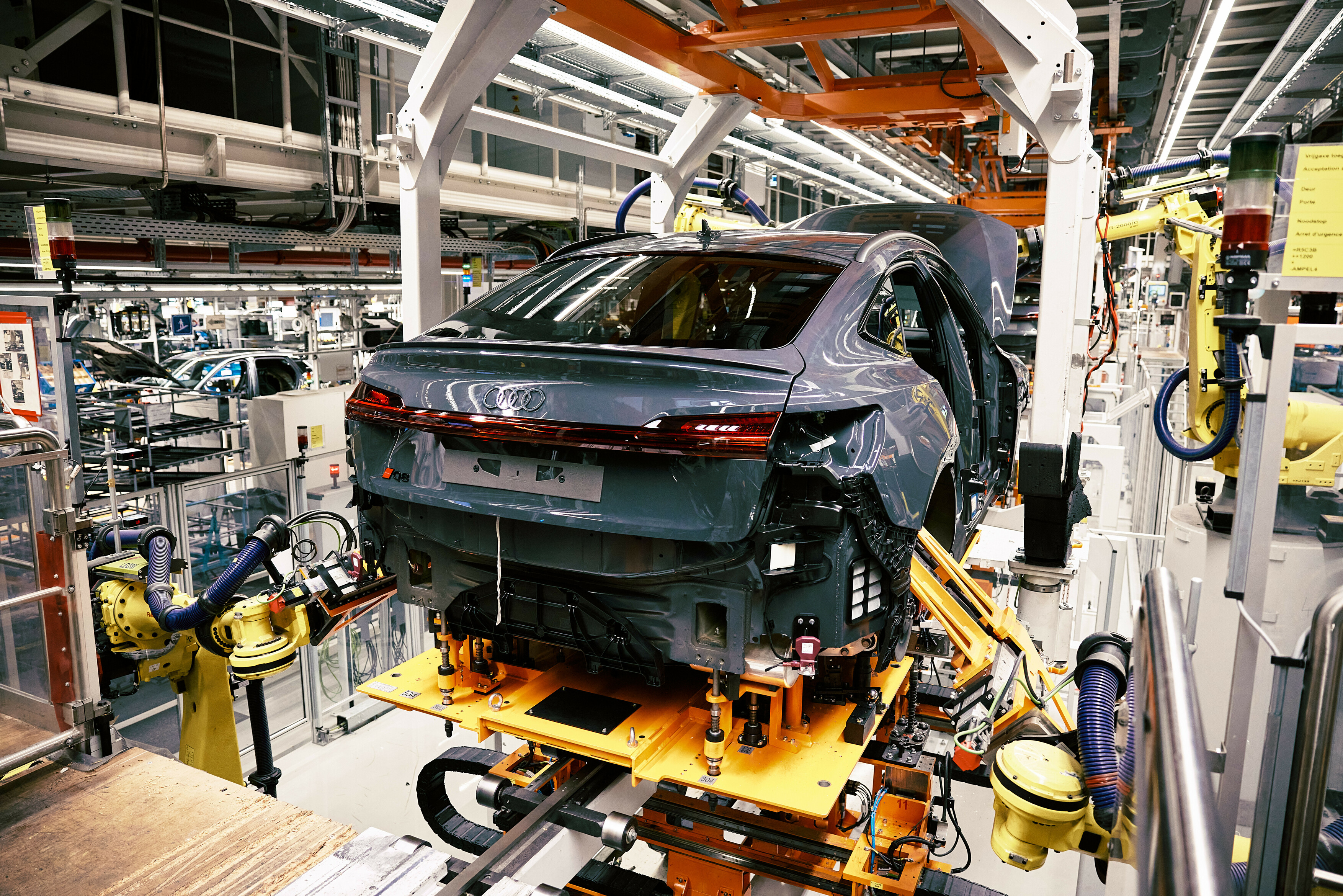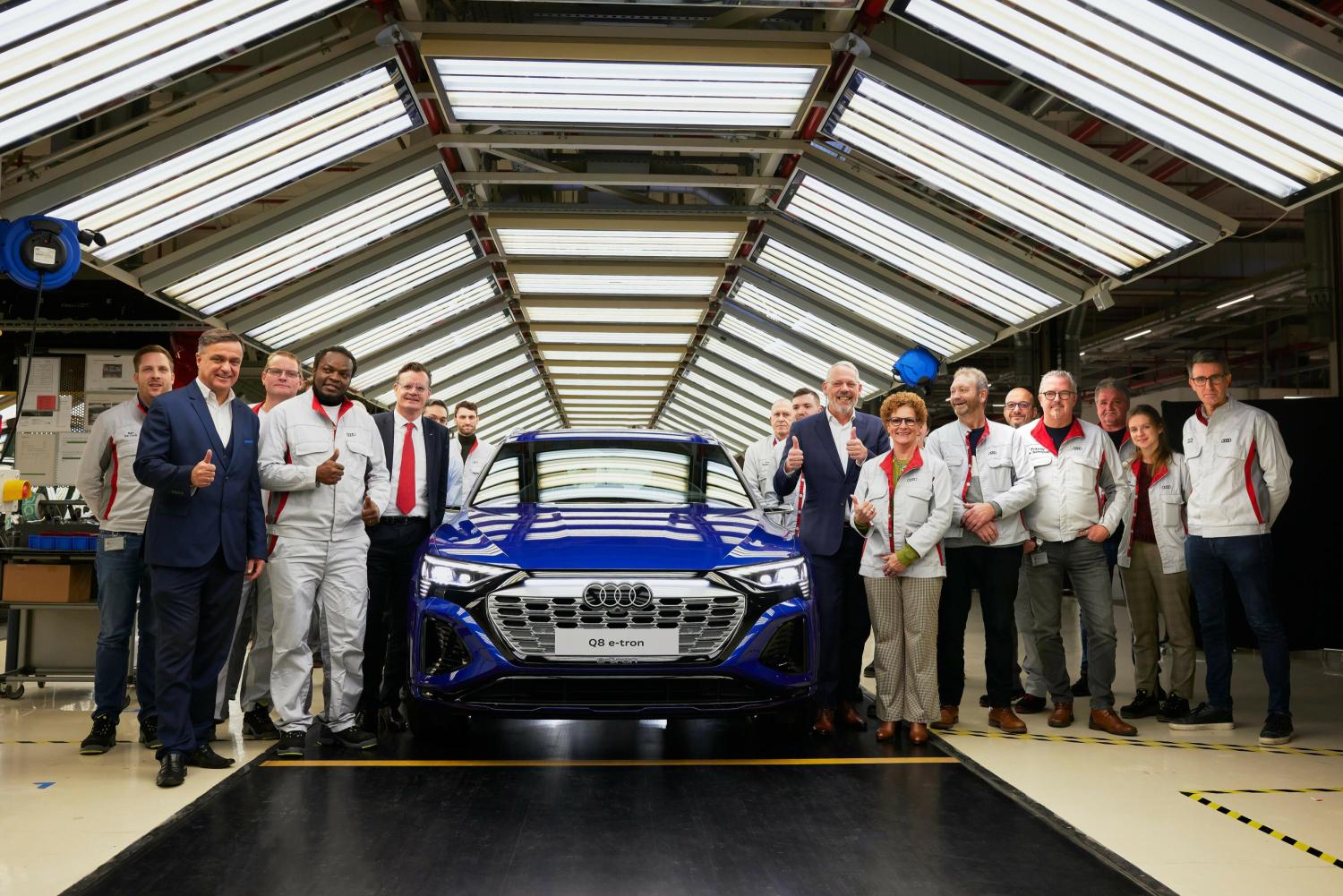On December 14, Audi began production of its new flagship electric vehicle (EV), the Q8 e-tron at the company’s Brussels, Belgium factory. The first one to roll off the line was an SUV in a striking electric-blue color, the second, a Sportback variant in gray with a sloping roofline, followed shortly after.
Along with other members of print and broadcast media, TriplePundit was invited to see these first two cars come off the production line. But as important as the launch of the new premium EV is undoubtedly for Audi, the company was just as enthusiastic to showcase the carbon-neutral facility in which the vehicle will be produced, too. We’ll cover both here.
Let’s talk about the Q8 e-tron first.
The car: the all-electric Audi Q8 e-tron
The new vehicle improves upon the existing e-tron SUV which Audi has been producing at the Brussels factory since 2018. The original all-electric e-tron was very well regarded, with the usual plush interior associated with the company’s vehicles as well as its sprightly performance and premium ride quality.
But in the increasingly competitive EV market place, the range of the original e-tron, specified at just 226 miles (EPA assessed), has become increasingly less impressive compared with newer vehicles released by the competition. And not just in the premium sector, but increasingly for EVs at considerably lower price points too.
Appropriately then, the new Q8 e-tron handsomely addresses the market’s increasingly lofty range expectations.
With improvements to aerodynamics, coupled with revised gearing and associated “rolling parts,” efficiency improvements have been recommended upon the Q8 e-tron’s platform. And with decreased weight, and improved performance from Audi’s battery packs (also assembled in the Brussels factory), substantially greater distances between charges are now possible for the new car.
Putting it all together, drivers of the new Q8 e-tron will be able to achieve up to 600 kilometers (375 miles) per charge from the Sportback version, featuring Audi’s 115 kWh battery pack. The SUV version, meanwhile, will achieve slightly less distance per charge at 582 kilometers (364 miles). It should be noted these distances are according to the Worldwide Harmonized Light Vehicle WLTP standard; the EPA typically assesses a somewhat shorter range. In any case, the Q8 e-tron will easily exceed the bar for its class, of well over 300 miles by the EPA’s assessment.
The Q8 e-tron should be easy to live with too. With the vehicle’s 170 kW charging capability, owners can expect to charge from 10 percent to 80 percent of full battery capacity in as few as 30 minutes from an appropriate fast charging station.
The rest of the package is familiar Audi, and we’d say, if it’s your brand, that’s exactly what you want it to be.
The factory in Brussels
And so onto the second part of the story, which Audi was keen to tell: the evolution of the Brussels factory in which the Q8 e-tron will be manufactured.
The factory dates back to the late 1940s, and was originally built by Volkswagen, Audi’s parent company, to produce the VW bug, (or Beetle, depending on where you’re from). Over the ensuing decades, numerous other VW models were produced there too.
Audi took over the plant in 2007 and began producing the sub-compact A1 model there, a popular small vehicle sold in many global markets but not in the US
The wheel brake of an Audi Q8 e-tron during assembly in Brussels
Then, after over 60 years of producing internal combustion engined vehicles, the Brussels factory began its transition to electrification in 2016 and in 2018, began production of the original e-tron SUV.
With the transition to producing electric vehicles, came the continuation of a transition to more sustainable production at the facility too. Audi says that investing in existing plants — rather than starting from scratch — is “sustainability in action – economically, ecologically and socially.”
Here are some of the notable developments at the factory.
The Brussels factory switched over to renewable energy in 2012 and embarked upon installing a 9,000 megawatt hours photovoltaic system — one of the regions’ largest — on the roof of the factory. Energy demands outside of this are met with solar and wind power, with carbon offsetting addressing any remaining shortfalls.
By the middle of next year, installation of a greywater system will be introduced to replace around 100,000 cubic meters of potable water used per year in the production process. Once in place, reuse of greywater will take place in a closed loop system.
Besides the factory itself, there is also focus on managing the supply chain to be as sustainable as possible too. Traction motors used in the new EVs are made in Hungary, and are transported to Brussels by sustainable rail freight, rather than by road, reducing the cars’ carbon footprint.
As for the battery cells which go into the assembly of the vehicle battery packs, these are purchased from third party suppliers, and Audi stipulates that its suppliers use only renewable energy in their production.
In combination, these efforts have led to the Brussels factory achieving certified carbon-neutral status since 2018, and lessons learned in the Brussels factory will contribute to the goal for all Audi plants to be carbon-neutral by 2025 under the company’s Mission-Zero program .
 The body and chassis of the Audi Q8 e-tron are connected
The body and chassis of the Audi Q8 e-tron are connected
The Q8 e-tron consequently will be delivered to customers in Europe and the US as a certified carbon-neutral car.
But with all of this said, we think one of the most important pillars of the transition of this car plant to electrification, is the human one.
Going from building traditional internal combustion engine vehicles for decades to EVs isn’t seamless. But Audi has invested over 1 million training hours in the facility’s 3,000 person workforce, to educate them in the transition to working on electrification.
So often with disruptive new technologies — which of course, electric vehicles are to the auto industry — legacy technologies are retired along with the workforces associated with them.
Audi’s focus on retraining workers proves instead that both facilities and staffing are adaptable as the industry shifts to EVs. Conversion to electrification is already proven at the Brussels factory, with 160,000 original e-trons already produced here since 2018.
Going forward, as well as the new Q8 e-tron, the Brussels factory will also produce an additional 40,000 of the smaller electric Q4 vehicles in the second half of 2023. For a factory that once produced the VW bug, it is already embracing an all-electric future that is coming at us almost.
Disclosure: Audi sponsored 3p’s participation in a media trip to Brussels.
Image credits: Audi media relations

